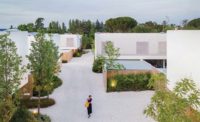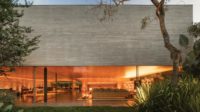Even as you approach, it is hard to spot the new house by Marcio Kogan, it blends so well into its natural setting. The concrete roof of this low-lying country retreat, two hours by car from São Paulo, is camouflaged by a grassy lawn on its top, making the strongly horizontal structure almost invisible from a road on higher ground. “We seek an architecture that has the least impact possible on the environment,” says Kogan, Brazil’s best-known architect. “The house becomes a continuation of the surrounding topography.”
Additional Content:
Jump to credits & specifications
The rectangular, poured-in-place concrete structure is large—11,000 square feet—but is all on one level (plus a basement), so the family can have immediate access to the outdoors from all parts of the dwelling. In conceiving the scheme, Kogan explored his interest in expressing a sense of horizontality, a fascination that goes back to his younger days, when he flirted with filmmaking and became obsessed with widescreen cinematography. (Since then, he has combined filmmaking with architecture in a handful of short films, the most known of which is Cat Kamillo’s Point of View of the Toblerone House of 2012.)
In much of Kogan’s architecture with his firm, studio mk27, strong horizontal roofs have become increasingly important. Here the roof functions as a plane that extends dramatically past the perimeter walls of the house, jutting out to shelter open-air living and dining areas to the south and car parking on the north. While the grassy roof is only accessible to the gardeners (using a ladder), it provides a natural means to insulate and cool the living quarters below, and was one reason the architects have applied for a sustainability rating from the Green Building Council Brasil.
At a slight remove, a freestanding perforated redbrick wall swoops around the house in serpentine curves along the east elevation, partially enclosing both short ends of the rectangular form. “It is probably the first curve in the history of the studio,” jokes Kogan about this subtle means of shielding the house from the road without sealing it off behind a solid wall.
The plan itself is divided lengthwise by a central corridor. On one side, facing east and the undulating brick wall, Kogan placed the kitchen, staff bedrooms, and a gym. On the other side are located the family’s bedrooms and baths, with views facing west within the sequestered community, out to a garden and a lake beyond.
When you arrive at the house from the parking area, you enter, by way of a retractable glass wall, the television room before stepping into the elongated hall that leads past bedrooms and services to the living and dining areas on the south. You can almost imagine a filmmaker’s tracking shot as you walk its length: while this axial route functions as a warm, wood-paneled gallery for the client’s photography collection, its dark, compressed space dramatizes your ultimate arrival at a large, glazed pavilion-like room where family and friends gather. Here the interior living/dining areas open up to expansive terraces, as well as a long, rectangular swimming pool.
In taking the journey from one end of the house to another, you may have wondered, “Where is the main entrance to this place?” Then you realize there isn’t one. But there is always nature beckoning: the floor-to-ceiling glass doors enclosing the interior communal spaces allow you to move effortlessly to a covered outdoor porch, past delicate steel columns supporting the roof, to the ipe-wood deck edging the pool.
The main architectural element shaping the space is the ceiling of exposed concrete, whose tactile board-formed surface directs the eye continually to vistas beyond. The floors, paved with a Brazilian basalt, and walls sheathed in yellow Brazilian freijo paneling add to the strong sense of planarity.
Altogether, the forceful concrete ceiling plane, the delicate steel columns, and the sinuous outdoor wall of perforated bricks dominate. By deploying these three elements, Kogan dramatizes the architectural experience of the domestic environment while hiding the structure in the landscape. You wish Cat Kamillo would make a comeback, prowling around these spaces, and somehow figuring out how to get up on that grassy roof.
CreditsArchitect: studio mk27 — Marcio Kogan, designer; Lair Reis, codesigner; Diana Radomysler, interiors; Carlos Costa, Carolina Castroviejo, Laura Guedes, Mariana Simas, Oswaldo Pessano, Pedro Ribeiro, Raquel Reznicek, Renato Périgo, Ricardo Ariza Miyabara, Suzana Glogowski, Tamara Lichtenstein, Thauan Miquelin, project team
Engineering: Afaconsult (structure, steel, m/e/p, foundation)
Consultants: Sustainability: CTE Automation: Noise Foundations: Apoio Air conditioning: Logitec Lighting: Lumini Landscaping: Maria João d'Orey
General Contractor: Fairbanks & Pilnik |
SpecificationsWood cladding, Paneling, Window frames, and Doors Plancus
Metal frames and skylights Tecnosystem
Custom woodwork Marvelar
Interior ambient lighting Lumini |












Post a comment to this article
Report Abusive Comment